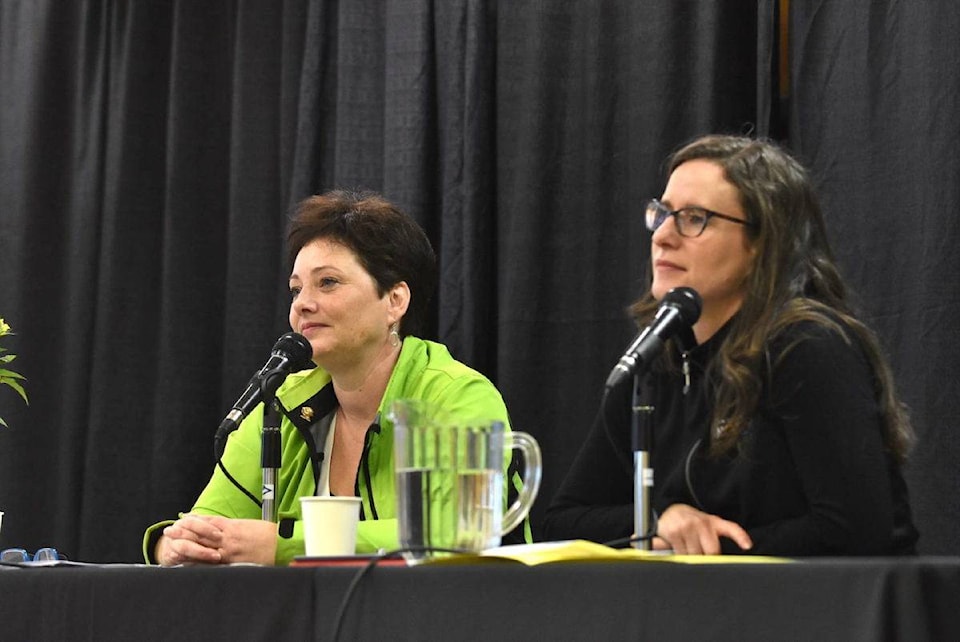As Amalgamation Yes continues a quest to unify the CRD’s municipalities, a Saturday town hall at the Mary Winspear in Sidney gave citizens a look into how Duncan and North Cowichan actually moved ahead.
The meeting featured Maeve Maguire, a North Cowichan councillor, and Mona Kaiser, a member of the Duncan-North Cowichan citizens’ assembly, who spoke about their experience with amalgamation and where the project stands today.
In her introduction, former Victoria councillor and member of Amalgamation Yes, Shellie Gudgeon, said she was saddened that amalgamation has become “a black and white issue.”
The group has realized over the years that eliminating the CRD would be impossible. So, instead of one unified municipality, they now believe three municipalities (the Victoria-area core, the West Shore, and the Peninsula) make more sense instead of 13. This concept, which would retain the CRD, was “geographically logical” and would “retain healthy competition,” she said, and is now their preferred concept.
One completed study, called the Capital Integrated Services and Governance Initiative, revealed a “profound depth of dysfunction” according to Gudgeon, but she added the study’s terms of reference covered only integrated services (emergency services, for example), not integrated governance.
During the last municipal election, Duncan and North Cowichan both voted in favour of an amalgamation study. Maguire summarized the process they went through. After deliberating, the citizens’ assembly recommended an answer to council. Council then approves their answer, turns it down, or asks for a delay. In this case, both councils approved the recommendation. Once council asks province to approve asking the question, it’s out of municipal hands.
They retained a Toronto-based consulting firm, MASS LBP, to facilitate the process. The company sent 10,000 mailout invitations to the community, from which 36 respondents were eventually chosen based on community representation and demographic diversity. The only thing linking them, said Kaiser, was “slightly nerdy wish to be part of this civic discussion.”
Of the four councillors who joined the citizens’ assembly (two each from North Cowichan and Duncan), none of them had a political agenda, which “is the key” according to Maguire. They wondered how they were going to get through the material in six full Saturdays, but Kaiser said the time pressure and diversity of the group was helpful.
“This is how we should go about untangling a tangled community issue.” said Kaiser. People can come with their opinions, but there is “educational scaffolding” where you can test your assumptions, she said.
“The answer isn’t always having more people in the room debating an issue,” said Kaiser. “The voices tend to get louder, not deeper.” Kaiser felt empowered by participating and presenting their findings to council and felt a “lite” version of this could work for many thorny issues.
“It was some of the most interesting volunteer work I’ve done in 15 years,” said Kaiser.
A long line of politicians approached the microphone, including Victoria Mayor Lisa Helps, Saanich Mayor Richard Atwell, Saanich North and the Islands MLA Adam Olsen and Peninsula-area councillors.
Atwell said amalgamation created tension in the local bureaucracy, as mergers might lead to job losses. Kaiser said a technical analysis revealed Duncan and North Cowichan actually would not save much money because they “ran very lean” as it was. The same number of citizens would still require services. While two municipal halls would not be required any more, for example, there would be costs to the transition. They were instead motivated by their shared sense of identity and how their viewed their community.
Helps asked how they got the Minister of Municipal Affairs and Housing to agree to fund a citizens’ assembly. Helps said Victoria requested a meeting on the issue and sent a letter a month ago with no response. Maguire said it was simply a different government with different priorities. The workload of the current NDP government likely factors into their response time.
North Saanich Councillor Murray Weisenburger said the municipal election, scheduled for Oct. 20, did not leave enough time to finish a citizens’ assembly, so he asked how long it would take to undertake the process. Maguire replied, “an entire term.”
The group did not start until late 2015 and was now “under the gun.” They preferred a referendum in April 2018, apart from the October election, but now it seems the October election is the only remaining option as the current Minister of Municipal Affairs and Housing, Selina Robinson, asked for more information from both municipalities before agreeing to put the question to the citizens. If that happens, both municipalities will elect separate councils in October. If citizens agree to amalgamate, a transition manager will be appointed who will be in charge of both municipalities, a joint budget, and another election where one amalgamated council will be chosen.
